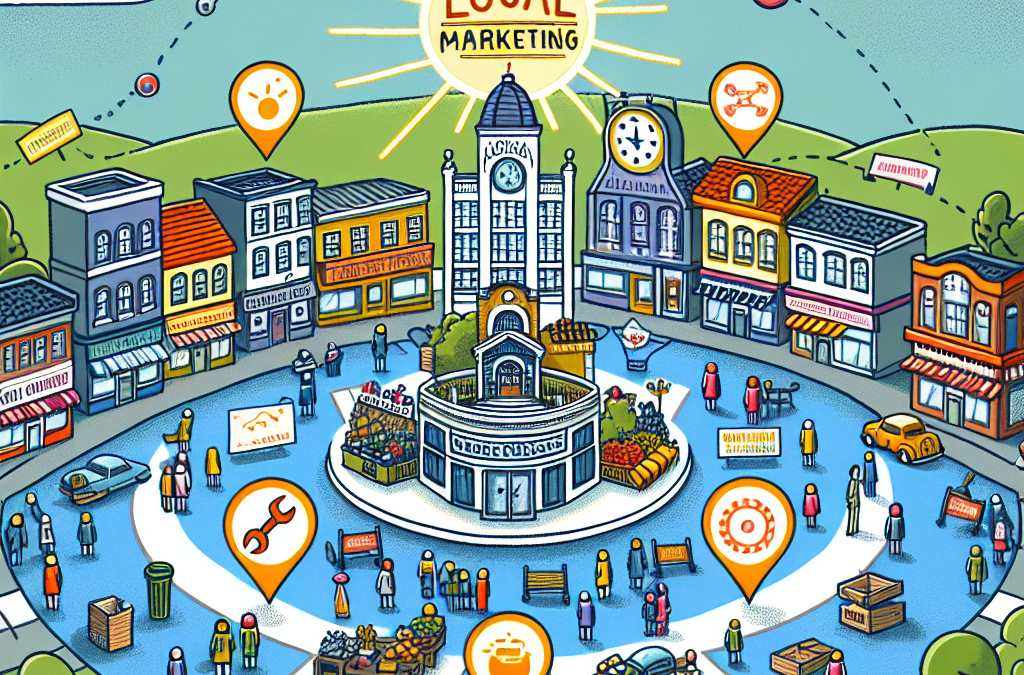Hey there! If you’re a business owner looking to take the next step, local marketing is where it’s at. I’ve been in the game for quite a while, and trust me, there’s a lot to unwrap here. In this article, I’ll break down the key areas of local marketing that can really drive growth. Let’s get into it!
Understanding Your Target Audience
Identifying Local Buyers
First things first, knowing who your audience is can make or break your marketing efforts. You want to dig deep and truly understand the people in your local area. What do they love? What problems do they have that your business can solve? Getting to know their preferences and habits is crucial.
To identify your local buyers, consider conducting surveys or gathering feedback from existing customers. Social media is another treasure trove of insights—check out local groups where your ideal customers hang out. You’d be surprised what you can learn when you take a step back and listen.
Once you’ve painted a picture of your target audience, segment them into groups. This will help you tailor your messaging and offers to resonate with each group, making your marketing more effective and personal.
Crafting Customer Personas
Creating customer personas can be a game changer. It’s basically developing semi-fictional characters that represent your ideal customers. You can base these personas on the research you’ve done about your audience. Think about their age, hobbies, income level, and even their buying motivations.
These personas become your guiding light when it comes time to create marketing materials. When you know who you’re speaking to, you can customize your messaging to hit the right notes. This keeps your campaigns relevant and engaging, which is what we want, right?
As your business evolves, make sure to update your customer personas. The local market can shift quickly, so staying in tune with the changes is essential to keep your marketing fresh.
Communicating Effectively
Once you’ve identified and understood your target audience, the next step is figuring out how to communicate with them. This includes choosing the right channels, be it social media, emails, local events, or even good old-fashioned flyers. The key is to meet your customers where they are.
Adapt your tone and messaging based on your audience’s preferences. If you’re catering to the younger crowd, a more casual and fun tone will likely resonate better than formal jargon. It’s all about being relatable and building a connection.
Always keep the lines of communication open. Whether it’s through social media comments, customer service inquiries, or in-person conversations, engaging with your audience allows you to create a loyal community around your brand.
Leveraging Local SEO
Optimizing Your Website
Search Engine Optimization, or SEO, is vital for local businesses wanting to stand out. Start by ensuring that your website is user-friendly and optimized for local searches. This includes integrating local keywords—think about search terms potential customers might use along with your business type.
Also, make sure you have a mobile-friendly site. More people are searching for local services on their smartphones than ever before. A responsive website can greatly improve user experience, keeping them engaged and more likely to convert.
Don’t forget about your Meta tags and descriptions! They may seem small, but these fields help search engines understand what your site is about. Ensuring they contain localized phrases can give you a little boost in search rankings.
Utilizing Google My Business
One of the best tools at your disposal is Google My Business (GMB). This listing is crucial for local search visibility and helps potential customers find you easily. Make sure to claim your GMB listing and fill out all the information accurately, including your business hours, location, and services.
Encourage happy customers to leave reviews on your GMB listing as well. These reviews not only build trust with new customers but also signal to Google that your business is a reputable source, which can help improve your search ranking.
Regularly update your GMB profile with posts, offers, and news about your business. Keeping it active shows that you’re engaged with your audience and that your business is alive and kicking!
Building Local Backlinks
Link building may sound technical, but it’s super important for your local SEO. Start by finding local websites that relate to your business. This could be local blogs, news sites, or industry-specific platforms. Reach out and see if they’d be interested in linking to your site or featuring your content.
You can also consider collaborating with local organizations or participating in community events. This not only fosters goodwill but often results in mentions and backlinks that boost your credibility in the eyes of search engines.
Creating valuable content that others want to link to is another great strategy. Blog posts that offer local insights, guides, or even infographics can draw attention and backlinks from other sites in your community.
Engaging with the Community
Participating in Local Events
You can’t underestimate the power of appearing in person at local events. Whether it’s a farmers market, a charity function, or a trade show, being present allows you to establish genuine connections with potential customers.
Having a booth or a presence at these events can dramatically increase your brand visibility. Plus, it’s a fantastic opportunity to showcase your products, engage with locals, and collect contacts for future promotions.
Don’t just show up and leave—be part of the community! Engage in discussions and show your support for local causes. This helps solidify your place within the community and builds relationships that can lead to customer loyalty.
Collaborating with Other Local Businesses
Team up with neighboring businesses for cross-promotions. You can host themed events, share each other’s posts on social media, or even bundle your products together for special offers. This not only broadens your reach but also fosters community spirit.
Forming partnerships can also introduce you to whole new groups of customers that you may not have reached otherwise. Think of it as a win-win situation where both businesses can enjoy the benefits of a shared audience.
Make sure to actively maintain these relationships. Regular check-ins and collaborative projects will help keep your network alive and thriving, ultimately contributing to sustained growth.
Utilizing Local Media
Don’t underestimate the impact of local media on your marketing strategy! Reach out to local newspapers, radio stations, or blogs to see if they’ll feature your business. Share your story—what makes you unique, your connection to the community, etc. You’d be surprised how interested they might be!
Crafting press releases for special events or milestones can also attract media attention. When local outlets share your news, it not only gives your business credibility but also ranges your outreach dramatically.
Creating relationships with local reporters can pay off in the long term. These connections can lead to regular features and mentions without you having to constantly pitch your business.
Measuring and Adjusting Your Strategy
Tracking Key Performance Indicators (KPIs)
So, you’ve executed your local marketing strategy—now what? The best way to know what’s working is by tracking specific performance indicators. These KPIs can range from website traffic and social media engagement to sales conversions and customer feedback.
Use tools like Google Analytics to monitor website performance, while social media platforms have their own insights to provide engagement stats. Digging deep into these metrics will bring clarity to what’s effective and what might need some tweaking.
Don’t just look at the numbers in isolation; combine them to get a full picture. For example, if you see an increase in website traffic but not in sales, it may point to issues in your sales funnel or product offerings.
Adapting Based on Feedback
Feedback from customers is gold. Make it a habit to listen to what your customers are saying about their experiences with your business. Utilize surveys, online reviews, and direct communication to gather this invaluable information. It highlights areas where you can improve and features you might promote more heavily.
Be responsive! If customers are voicing concerns or suggestions, addressing these promptly can be a game changer. Not only does it show that you care, but it also enhances customer loyalty and satisfaction.
Above all, be prepared to pivot based on feedback. Flexibility in your marketing strategy will help you stay relevant and effective in a constantly shifting market. Adapt and evolve to suit your customers’ needs, and you can’t go wrong!
Refining Your Campaigns over Time
Marketing is not a one-and-done deal. It’s an ongoing process of learning and growing. Regularly revisit your campaigns to see if they’re hitting the mark. This might mean fine-tuning your messaging, switching up your strategies, or trying out new platforms altogether.
Additionally, testing new techniques can be super beneficial. A/B testing your ads, trying new content formats, or experimenting with different promotions can yield surprising results. Track the outcomes diligently and don’t be afraid to adjust your approach accordingly.
Set aside time, maybe quarterly, to assess what’s working and what isn’t in your local marketing strategy. The marketplace is always evolving, and you should too!
FAQ
What is local marketing?
Local marketing focuses on reaching customers within a specific geographic area. It’s all about targeting and engaging with your local community to drive foot traffic and online sales.
Why is understanding my target audience important?
Knowing your target audience helps tailor your marketing efforts to resonate with their needs and preferences, increasing engagement and conversions.
What is local SEO, and why should I use it?
Local SEO boosts your online visibility in local search results. Optimizing your website and online profiles helps potential customers find you when searching for products or services in your area.
How can I engage with my community effectively?
Engaging with your community involves participating in local events, leveraging collaborations with other businesses, and being active on social media. Authentic connections go a long way!
How do I measure the success of my local marketing efforts?
Tracking KPIs such as website traffic, customer feedback, and sales metrics will help assess the effectiveness of your local marketing strategies. Regular reviews and adjustments keep your approach fresh.
This article provides a comprehensive overview of local marketing, emphasizing engagement, communication, and continuous adaptation based on the market. It encourages business owners to understand their audience and leverage local SEO while befriending the community for sustainable growth.


